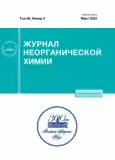Photoinduced Dynamics of Spin Centers in Carbon-Modified Titanium Dioxide Nanotubes
- Авторлар: Kytina E.V.1, Savchuk T.P.1,2, Gavrilin I.M.2, Konstantinova E.A.1
-
Мекемелер:
- Moscow State University
- National Research University of Electronic Technology
- Шығарылым: Том 68, № 3 (2023)
- Беттер: 419-425
- Бөлім: НЕОРГАНИЧЕСКИЕ МАТЕРИАЛЫ И НАНОМАТЕРИАЛЫ
- URL: https://journals.rcsi.science/0044-457X/article/view/136347
- DOI: https://doi.org/10.31857/S0044457X22601201
- EDN: https://elibrary.ru/JBOVJY
- ID: 136347
Дәйексөз келтіру
Толық мәтін
Аннотация
Arrays of titanium dioxide (TiO2) nanotubes with different chemical compositions have been synthesized; their structural properties have been studied, and the characteristics of spin centers (defects) have been determined. All samples have appeared to contain carbon. It has been established that the main type of spin centers in TiO2 nanotubes are dangling carbon bonds, and their concentration correlates with the carbon content in the obtained structures. Under illumination, a reversible increase in the concentration of defects occurs, which is caused by their photoinduced recharging in the process of impurity absorption. This process is accompanied by an increase in the concentration of photoexcited electrons in the conduction band. The originality and novelty of the work are determined by the development of a method for controlling the density of defects and, accordingly, the concentration of photoinduced electrons by thermal treatment of samples under various conditions. The results open up new possibilities for the development of photocatalysts based on titanium dioxide nanotubes with a controlled electron concentration in the conduction band that function in the visible range of the spectrum.
Негізгі сөздер
Авторлар туралы
E. Kytina
Moscow State University
Email: wewillbe01@gmail.com
119991, Moscow, Russia
T. Savchuk
Moscow State University; National Research University of Electronic Technology
Email: wewillbe01@gmail.com
119991, Moscow, Russia; 124498, Zelenograd, Moscow, Russia
I. Gavrilin
National Research University of Electronic Technology
Email: wewillbe01@gmail.com
124498, Zelenograd, Moscow, Russia
E. Konstantinova
Moscow State University
Хат алмасуға жауапты Автор.
Email: wewillbe01@gmail.com
119991, Moscow, Russia
Әдебиет тізімі
- Dongmei He, Liyong Du, Keyan Wang et al. // Russ. J. Inorg. Chem. 2021. V. 66. P. 1986. https://doi.org/10.1134/S0036023621130040
- Sadovnikov A.A., Nechaev E.G., Bel’tyukov A.N. et al. // Russ. J. Inorg. Chem. 2021. V. 66. P. 460. https://doi.org/10.1134/S0036023621040197
- Dolganov A.V., Balandina A.V., Chugunov D.B. et al. // Russ. J. Gen. Chem. 2020. V. 90. P. 1229. https://doi.org/10.1134/S1070363220070099
- Jenny Schneider, Masaya Matsuoka, Masato Takeuchi et al. // Chem. Rev. 2014. V. 114. P. 9919. https://doi.org/10.1021/cr5001892
- Jingxiang Low, Jiaguo Yu, Mietek Jaroniec et al. // Adv. Mater. 2017. V. 29. № 20. P. 1601694. https://doi.org/10.1002/adma.201601694
- Martin Motola, Hanna Sopha, Miloš Krbal et al. // Electrochem. Commun. 2018. V. 97. № 1. P. 1. https://doi.org/10.1016/j.elecom.2018.09.015
- Кривобок В.С. // Письма в ЖЭТФ. 2020. Т. 112. № 8. С. 501. https://doi.org/10.31857/S1234567820200033
- Zubair M., Kim H., Razzaq A. et al. // J. CO2 Utiliz. 2018. V. 26. P. 70. https://doi.org/10.1016/j.jcou.2018.04.004
- Jaafar H., Ahmad Z.A., Ain M.F. et al. // Optik. 2017. V. 144. P. 91. https://doi.org/10.1016/j.ijleo.2017.06.097
- Zhao W., Liu S., Zhang S. et al. // Catal. Today. 2019. V. 337. P. 37. https://doi.org/10.1016/j.cattod.2019.04.024
- Tang T., Yin Z., Chen J. et al. // Chem. Eng. J. 2021. V. 417. P. 128058. https://doi.org/10.1016/j.cej.2020.128058
- Константинова Е.А., Миннеханов А.А., Кытина Е.В., Трусов Г.В. // Письма в ЖЭТФ. 2020. Т. 112. № 8. С. 562. https://doi.org/10.1134/S0021364020200060
- Wei Y., Huang Y., Fang Y. et al. // Mater. Res. Bull. 2019. V. 119. P. 110571. https://doi.org/10.1016/j.materresbull.2019.110571
- Xiao Y., Sun X., Li L. et al. // Chin. J. Catal. 2019. V. 40. № 5. P. 765. https://doi.org/10.1016/s1872-2067(19)63286-9
- So S., Riboni F., Hwang I. et al. // Electrochim. Acta. 2017. V. 231. P. 721. https://doi.org/10.1016/j.electacta.2017.02.094
- Motola M., Čaplovičová M., Krbal M. et al. // Electrochim. Acta. 2020. V. 331. P. 135374. https://doi.org/10.1016/j.electacta.2019.135374
- Kar P., Zeng S., Zhang Y. et al. // Appl. Catal. B: Environmental. 2019. V. 243. P. 522. https://doi.org/10.1016/j.apcatb.2018.08.002
- Savchuk T., Gavrilin I., Konstantinova E. et al. // Nanotechnology. 2021. V. 33. P. 055706. https://doi.org/10.1088/1361-6528/ac317e
- Gavrilin I., Dronov A., Volkov R. et al. // Appl. Surf. Sci. 2020. V. 516. P. 146120. https://doi.org/10.1016/j.apsusc.2020.146120
- Hu L., Huo K., Chen R. et al. // Anal. Chem. 2021. V. 83. P. 8138. https://doi.org/10.1021/ac201639m
- Zhi-Da Gao, Xu Zhu, Ya-Hang Li et al. // Chem. Commun. 2015. V. 51. P. 7614. https://doi.org/10.1039/c5cc00728c
- Yan-Yan Song, Ya-Hang Li, Jing Guo et al. // J. Mater. Chem. A. 2015. V. 3. P. 23754. https://doi.org/10.1039/c5ta05691h
- Zhao H., Pan F., Li Y. et al. // J. Materiomics. 2017. V. 3. P. 17. https://doi.org/10.1016/j.jmat.2016.12.001
- Wedland W., Hecht H. Reflectance Spectroscopy. N.Y.: Interscience, 1966.
- Minnekhanov A.A., Deygen D.M., Konstantinova E.A. et al. // Nanoscale Res. Lett. 2012. V. 7. P. 333. https://doi.org/10.1186/1556-276X-7-333
Қосымша файлдар













